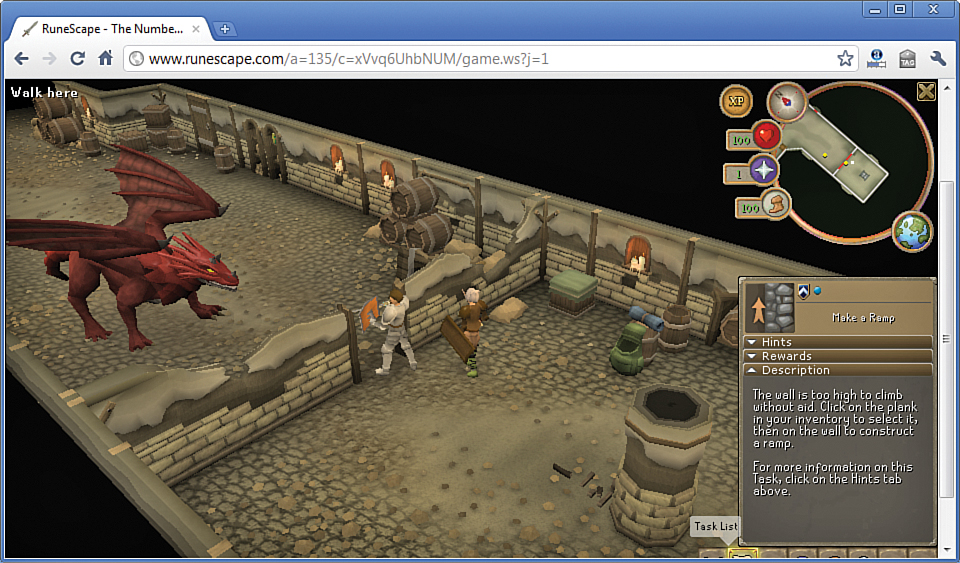First Stop: Oracle
The Java vacation begins at www.java.com, a site created by Oracle, the company that owns the Java language.
A Java program that runs as part of a web page is called an applet. Applets are placed on pages like other elements of a page. A markup language called HTML defines where the program should be displayed, how big it is, and what the program does when it runs. Java also enhances the Web in two other ways: Desktop programs written in Java can be launched from a web browser, and Java servlets are run by web servers to deliver web applications.
Oracle’s Java division leads the development of the Java language and related software. The Java in Action section of Java.com showcases how Java is being used on websites, Android phones, and other platforms. Millions of devices run programs written with Java. Figure 3.1 shows RuneScape, a massively multiplayer online game powered by Java. You can play the game for free by using any web browser to visit www.runescape.com.
Figure 3.1. The Java-powered online game RuneScape.

Java.com provides a place to learn about how Java is being used. Oracle also offers a more technically oriented website for Java programmers at http://www.oracle.com/technetwork/java. This site is the place to find the latest released versions of NetBeans and the Java Development Kit along with other programming resources.
A Brief History of Java
Bill Joy, one of the executives at Sun Microsystems when the company created Java, called the language “the end result of 15 years of work to produce a better, more reliable way to write computer programs.” Java’s creation was a little more complicated than that.
Java was developed in 1990 by James Gosling as a language that would serve as the brains for smart appliances (interactive TVs, omniscient ovens, SkyNet military satellites that enslave mankind, and so on). Gosling was unhappy with the results he was getting by writing programs with a programming language called C++. In a burst of inspiration, he holed up in his office and wrote a new language to better suit his needs.
Gosling named his new language Oak after a tree he could see from his office window. The language was part of his company’s strategy to make a fortune when interactive TV became a multimillion-dollar industry. That still hasn’t happened today (though Netflix, TiVo, and others are making a game attempt), but something completely different took place for Gosling’s new language. Just as Oak was about to be scrapped, the Web became popular.
You might have heard that Java is an acronym that stands for Just Another Vague Acronym. You also might have heard that it was named for the Gosling’s love of coffee. The story behind Java’s naming contains no secret messages or declarations of liquid love. Java was chosen as the name for the same reason that comedian Jerry Seinfeld likes to say the word salsa: It sounds cool.
In a fortuitous circumstance, many qualities that made Gosling’s language good on its appliance project made it suitable for adaptation to the Web. His team devised a way for programs to be run safely from web pages and a catchy new name was chosen to accompany the language’s new purpose: Java.
Although Java can be used for many other things, the Web provided the showcase it needed. When the language rose to prominence, you had to be in solitary confinement or a long-term orbital mission to avoid hearing about it.
There have been eight major releases of the Java language:
• Fall 1995: Java 1.0—The original release
• Spring 1997: Java 1.1—An upgrade that improved support for graphical user interfaces
• Summer 1998: Java 2 version 1.2—A huge expansion, making the language a general-purpose programming language
• Fall 2000: Java 2 version 1.3—A release for enhanced multimedia
• Spring 2002: Java 2 version 1.4—An upgrade of Internet support, XML capabilities, and text processing
• Spring 2004: Java 2 version 5—A release offering greater reliability and automatic data conversion
• Winter 2006: Java 6—A upgrade with a built-in database and web services support
• Summer 2011: Java 7—The current release, which adds new core language improvements, memory management improvements, and the Nimbus graphical user interface
